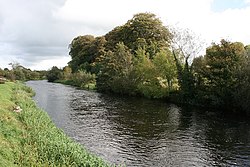This article is about the river tributary of the River Shannon in Ireland. For the river in Cornwall, see River Inny, Cornwall. For the river in the Iveragh Peninsula, County Kerry, Ireland, see River Inny, Kerry.
| River Inny | |
|---|---|
 River Inny, Ballymahon River Inny, Ballymahon | |
| Etymology | From the mythological figure Ethniu |
| Native name | An Eithne (Irish) |
| Location | |
| Country | Ireland |
| Physical characteristics | |
| Source | |
| • location | Near Oldcastle and Loughcrew, County Meath |
| Mouth | |
| • location | Lough Ree (River Shannon) |
| Length | 88.5 kilometres (55.0 mi) |
| Basin size | 1,254 km (484 sq mi) |
| Discharge | |
| • average | 18.4 m/s (650 cu ft/s) |
| Basin features | |
| River system | River Shannon |
The River Inny (Irish: An Eithne) is a river within the Shannon River Basin in Ireland. It is 88.5 kilometres (55.0 mi) in length, and has a number of lakes along its course.
Etymology
The river's name derives from the mythological figure Ethniu or Eithne, who reputedly died in rapids in its lower reaches.
Course

The Inny begins as a stream at Slieve na Calliagh, in the townland of Tubride, near Oldcastle, a hilly area which holds the complex of megalithic tombs now more often named for Loughcrew, all in County Meath. In its upper reaches, it marks the boundary between Counties Meath and Cavan for about a short distance before it enters Lough Sheelin, which lies at a meeting points of Counties Cavan, Meath and Westmeath. The portion as far as Lough Sheelin is also sometimes known as the Upper Inny, or the Ross River.
At Lough Sheelin, multiple tributaries join, including the Mountnugent (Mount Nugent) River and the Bellsgrove (or Belsgrove, also known as Ballyheelan) and Crover Streams, as well as the Mauraghboy, Carrick, Rusheen, Moneybeg and Schoolhouse Streams. The Upper Inny and Lough Sheelin are on limestone, while some of the Lough Sheelin tributaries flow over quartzite.
From Lough Sheelin, the Inny, sometimes known as the Lower Inny from here on, forms the boundary between Westmeath and Cavan. It flows under the bridge at the village of Finea, and into Lough Kinale, where counties Cavan and Westmeath meet Longford. From there the river forms much of the boundary between Longford and Westmeath but enters Westmeath near Streete and flows into Lough Derravaragh, known for its role in the legend of the Children of Lir. It then flows near the village of Ballinalack, forms Lough Iron, and crosses into County Longford near Abbeyshrule, where the Whitworth Aqueduct suspends the Royal Canal above the river, and pumps supply the canal with water. At nearby Tenelick the mythological Princess Eithne drowned in the rapids, giving her name to the river, which powered two mills here for many years. It continues past Newcastle House to Ballymahon.
Downstream of Ballymahon, the Inny again forms the county line between Longford and Westmeath, and runs westwards into Lough Ree at Inny Bay. Lough Ree is the second major lake of the River Shannon which drains into the Atlantic Ocean.
In the 1960s the river was drained which removed the weir at Newcastle, this fed a generator and a sawmill for the "big house" nearby. It also closed off the millrace and millpond to the ruined mill at the bridge in Ballymahon. This silenced the waterfall at the mill which had roared for about 100 years.
References
- ^ "Fishing and the River Inny". Longford.ie. Longford County Council. Archived from the original on 18 May 2015. Retrieved 25 March 2020.
- ^ "The River Inny". Ireland Reaching Out. Archived from the original on 10 February 2015. Retrieved 26 March 2020.
- ^ Champ, T.; Kerins, C.; Monaghan, K. (2007). "Lough Sheelin and its catchment - water quality status and nutrient loadings, 1998-2005". Shannon Regional Fisheries Board. Archived from the original on 15 March 2016. Retrieved 24 March 2020.
- Environmental River Enhancement Programme - Annual Report 2013. Swords, Co. Dublin: Inland Fisheries Ireland and the Office of Public Works. 2014. p. 30.
Both Mount Nugent and Mountnugent forms shown
- "The Quality of River and Lake Water in County Cavan: Lough Sheelin Feeder Streams" (PDF). Cavan County Council. Cavan: Cavan County Council. 2013. p. 84. Archived (PDF) from the original on 24 May 2019. Retrieved 21 March 2020.
- "Lough Sheelin Guide" (PDF). This is Cavan. The Shannon Regional Fisheries Board via This is Cavan. Archived (PDF) from the original on 24 March 2020. Retrieved 24 March 2020.
- Williams, Robert A. (1872). Notes on River Basins. London: Longmans, Green and Co. p. 64.
... forms Loughs Sheelin and Derevaragh; passes n(ear) Granard, and Ballymahon
- ^ "Geohive (integrated State mapping)". Ordnance Survey Ireland (incl. Geohive). Government of Ireland. Archived from the original on 2 April 2020. Retrieved 26 March 2020.
External links
| River Shannon, Ireland (Basin) | |
|---|---|
| Counties | |
| Settlements | |
| Major tributaries | |
| Flows into | |
| Linked canals | |
| Major crossings |
|
| Rivers of Ireland | |
|---|---|
| List | |
| Flowing north | |
| Flowing to the Irish Sea | |
| Flowing to the Celtic Sea | |
| Flowing to the Atlantic | |
| Tributaries of the Shannon | |
| River names in italics indicate rivers which are partially or wholly in Northern Ireland, with the rest being wholly in the Republic of Ireland | |
51°51′N 10°11′W / 51.850°N 10.183°W / 51.850; -10.183
Categories: